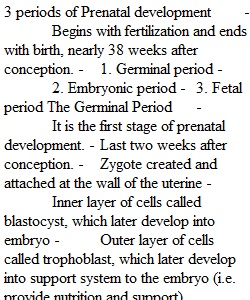


Q Read/Study Chapter Two: Biological Beginnings and Chapter Three: Prenatal Development in your textbook: Children, 14e. Using the Assignment tool, create and submit Two-Column Notes for JUST Chapter Three. Make sure to use only your own words and proofread your work to catch errors. As stated before: You may NOT quote or copy any other sources (including from the internet or another classmate). Two column notes are a method of summarizing the chapter which requires a minimum of writing and still displays your understanding of the material. On a standard page, you divide the page into two columns--I make the left column about 1/3 and the right column about 2/3rds of the page—in the left column you write the central terms, ideas or headings (you can refer to the Chapter’s Table of Contents for help) and in the right column you write phrases for each of the sub-points under that heading or important idea. The easiest way to create columns that line up and can be easily manipulated is to open the "Insert" tab on the Tool Bar and then select "Table". Click on two blocks across and all down. If you need to add more blocks you can use your enter key to add more when you get to the last block. Please use excellent spelling and grammar.
View Related Questions